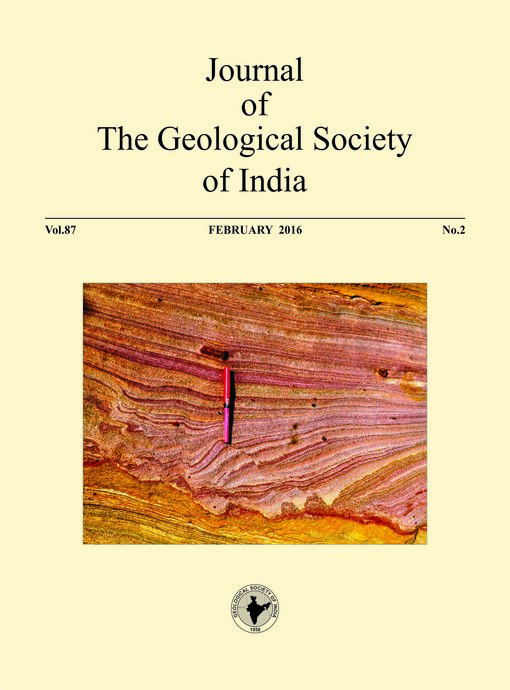Identification of Chrysotile in Local Soil at Beypinari Village
Keywords:
Chrysotile, Asbestos, Characterization, Health, Sivas, Turkey.Abstract
Asbestos is dangerous for health and is forbidden to use in Turkey, but villagers who live in rural eastern part still use it especially for their home for insulation purposes and even as a substitute for baby powder. Therefore, geological and chemical properties of this type of soil, which is near the settlement, should be characterized and identified from the point of view of health. Beypinari asbestos deposits are located at Beypinari village, about 90 km southeast of Sivas, Turkey within Central Anatolian Ophiolites. Therefore, in the present study, the existence of chrysotile in Beypinari asbestos deposit were characterized and identified by mineralogical analysis and by major, trace, REE analysis. The results show that the samples contain different amount of calcite mineral, the main mineral being chrysotile.Downloads
Issue
Section
Downloads
Published
How to Cite
References
ANTAO, V.C., LARSON, T.C. and HORTON, D.K. (2012) Libby vermiculite exposure and risk of developing asbestos-related lung and pleural diseases. Current Opinion in Pulmonary Medicine 18, pp.161-167.
ATSDR (Agency for Toxic Substances and Disease Registry) (2001) Toxicological Profile for Asbestos. Department of Health and Human Services, Public Health Service, Agency for Toxic Substances and Disease Registry, USA
BARIS, Y. I., BILIR, N., ARTVINLI, M., SAHIN, A. A., KALYONCU, F. and SEBASTIEN, P. (1988) An epidemiological study on an Anatolian village environmentally exposed to tremolite asbestos. British Journal of Industrial Medicine v.45, pp.838– 840.
BERKHEISER, V.E. (1982) Adsorption of stearic acid by chrysotile. Clays and Clay Minerals, v.30, pp.91-96.
BERMAN, D.W. (2011) Apples to apples: the origin and magnitude of differences in asbestos cancer risk estimates derived using varying protocols. Risk Analysis, v.31, pp.1308–1326.
BOKE, H., AKKURT, S., OZDEMIR, S., GOKTURK, E.H. and CANER SALTIK, E.N. (2004) Quantification of CaCO3-CaSO3.0.5H2O-CaSO 4.2H2O mixtures by FTIR analysis and its ANN model. Materials Lett., v.558, pp.723-726.
FONCESCA, M.G., OLIVEIRA, A.S. and AIROLDI, C. (2001) Silylating Agents Grafted on to Silica Derived from Leached Chrysotile. Jour. Colloid and Interface Sci., v.240, pp.533-538.
FUJISHIGE, M., KURIBARA, A., KARASAWA, I. and KOJIMA, A. (2007) Low-temperature pyrolysis of crocidolite and amosite using calcium salts as a flux. Jour. Ceramic Soc. Japan, v.15, pp.434– 439.
GOODMAN, J.E., PETERSON, M.K., BAILEY, L.A., KERPER, LE. and DODGE, D.G. (2013) Electricians' chrysotile asbestos exposure from electrical products and risks of mesothelioma and lung cancer. Regulatory Toxicology and Pharmacology v.68 (1), pp.8-15.
HODGSON, J.T. and DARNTON, A. (2010) Mesothelioma risk from chrysotile. Occupational and Environmental Medicine, v.67(6), 432p.
Inan, N. and Inan, S. (1990) GíœRLEVIK KIREí‡TASLARININ (Sivas) özellikleri ve önerilen yeni isim: Tecer Formasyonu (in Turkish). Turkish Geol. Bull., v.33, pp.51-56.
JOLICOEUR, C. and DUCHESNE, D. (1981) Infrared and thermogravimetric studies of the thermal degredation of chrysolite asbestos fibers: evidence of matrix effects. Canadian Journal of Chemistry, v.59, pp.1521-1526.
KAKOOEI, H., MESHKANI, M. and AZAM, K. (2013) Ambient monitoring of airborne asbestos in non-occupational environments in Tehran, Iran. Atmospheric Environment, v.81, pp.671-675.
KUSIOROWSKI, R., ZAREMBA, T., PIOTROWSKI, J. and ADAMEK, J.(2012) Thermal decomposition of different types of asbestos. Jour. Thermal Analysis and Calorimetry v.109(2), pp.693704.
LE G.V., TAKAHASHI, K., PARK, E.K., DELGERMAA, V., OAK, C., QURESHI, A.M. and ALJUNID, S.M. (2011) Asbestos use and asbestos-related diseases in Asia: past, present and future. Respirology, v.16, pp.767-775.
LE G.V., TAKAHASHI, K., KARJALAINEN, A., DELGERMAA, V., HOSHUYAMA, T., MIYAMURA, Y., FURUYA, S., HIGASHI, T., PAN, G. and WAGNER, G. (2010) National use of asbestos in relation to economic development. Environmental Health Perspect, v.118, pp.116-119.
LEE, H.J., PARK, E.K., WILSON, D., TUTKUN, E. and OAK, C. (2013) Awareness of Asbestos and Action Plans for Its Exposure can Help Lives Exposed to Asbestos. Safety and Health at Work, v.4, pp.84-86.
LOOMIS, D., DEMENT, J.M., WOLF, S.H. and RICHARDSON, D.B. (2009) Lung cancer mortality and fibre exposures among North Carolina asbestos textile workers. Occupational and Environmental Medicine, v.66, pp.535-542.
MCCORMACK, V., PETO, J., BYRNES, G., STRAIF, K. and BOFFETTA, P. (2012) Estimating the asbestosrelated lung cancer burden from mesothelioma mortality. British Jour. Cancer, v.106, pp.575584.
MUMPTON, F. A. and THOMPSON, C.S. (1975) Mineralogy and origin of the Coalinga asbestos deposit. Clays and Clay Minerals, v.23, pp.131-143.
Post, J.L. and Borer, L. (2002) High resolution infrared spectra, physical properties, and micromorphology of serpentines. Applied Clay Sci., v.16, pp.73-85.
SELCUK, Z.T., í‡OPLU, L., EMRI, S., KALYONCU, A. F., SAHIn, A.A., Baris, Y.I. (1992) Malignant pleural mesothelioma due to environmental mineral fiber exposure in Turkey. Chest v.102, pp.790-796.
SUQUET, H., 1989. Effects of dry grinding and leaching on the crystal structure of Chrysotile. Clays and Clay Minerals, v.37(5), pp.439-445.
TOURNERET, L., BERGER, F., MAVON, C. and CHAMBAUDET, A., 1999. Calcium sulphate formation during the heat-up period: some essential parameters. Applied Clay Sci., v.14, pp.299-317.
WORLD HEALTH ORGANIZATION (WHO), (1986) Asbestos and Other Natural Mineral Fibres. Report to United Nations Environment Programme.
WICKS, F.J. and Whittaker, E.J.W. (1977) Serpentine textures and serpentinization. The Canadian Mineralogist v.15, pp.459-488.
YAZICIOGLU, S., ILCAYTO, R., BALCI, K., SAYLI, B.S. and YORULMAZ, B. (1980) Pleural calcification, pleural mesotheliomas and bronchial cancers caused by tremolite dust. Thorax v.35, pp.564–569.
YALINIZ, M.K. and GONCUOGLU, M.C. (1999) Clinopyroxene compositions of the isotropic gabbros from the Sarikaraman Ophiolite: New evidence on supra subduction zone type magma genesis in central Anatolia. Jour. Earth Sci., v.8, pp.103-111.
YARIV, S. and KALLAI, L.H. (1975) The relationship between the I.R. spectra of serpentines and their structures. Clays and Clay Minerals, v.23, pp.145-152.

 Yunus Onala
Yunus Onala


